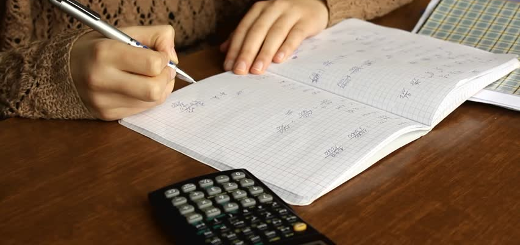Calcule a amplitude do ângulo formado pela diagonal do cubo com qualquer das suas arestas
Geometria Analítica: Infinito 11 A - Parte 1 Pág. 180 Ex. 20
Seja $(O,\vec{i},\vec{j},\vec{k})$ um referencial o. n. do espaço.
- Calcule a amplitude do ângulo formado pela diagonal de um cubo com qualquer das suas arestas.
- O vetor ${\vec{u}}$ é tal que $\vec{u}=2\vec{i}+2\vec{j}+2\vec{k}$.
Indique, em radianos, uma medida de $(\vec{u}\overset{\hat{\ }}{\mathop{{}}}\,\vec{i})$, de $(\vec{u}\overset{\hat{\ }}{\mathop{{}}}\,\vec{j})$ e de $(\vec{u}\overset{\hat{\ }}{\mathop{{}}}\,\vec{k})$.
-
Consideremos um cubo com aresta de comprimento a, associado a um referencial o. n., como indicado na figura.
As coordenadas dos vetores assinalados são: $\overrightarrow{OA}=(a,0,0)$, $\overrightarrow{OC}=(0,a,0)$, $\overrightarrow{OD}=(0,0,a)$ e $\overrightarrow{OF}=(a,a,a)$.
Ora,
$\begin{array}{*{35}{l}}
\cos (\overrightarrow{OA}\overset{\hat{\ }}{\mathop{{}}}\,\overrightarrow{OF}) & = & \frac{(a,0,0).(a,a,a)}{\sqrt{{{a}^{2}}}\times \sqrt{{{a}^{2}}+{{a}^{2}}+{{a}^{2}}}} \\
{} & = & \frac{{{a}^{2}}}{a\times a\sqrt{3}} \\
{} & = & \frac{\sqrt{3}}{3} \\
\end{array}$$\begin{array}{*{35}{l}}
\cos (\overrightarrow{OC}\overset{\hat{\ }}{\mathop{{}}}\,\overrightarrow{OF}) & = & \frac{(0,a,0).(a,a,a)}{\sqrt{{{a}^{2}}}\times \sqrt{{{a}^{2}}+{{a}^{2}}+{{a}^{2}}}} \\
{} & = & \frac{{{a}^{2}}}{a\times a\sqrt{3}} \\
{} & = & \frac{\sqrt{3}}{3} \\
\end{array}$$\begin{array}{*{35}{l}}
\cos (\overrightarrow{OD}\overset{\hat{\ }}{\mathop{{}}}\,\overrightarrow{OF}) & = & \frac{(0,0,a).(a,a,a)}{\sqrt{{{a}^{2}}}\times \sqrt{{{a}^{2}}+{{a}^{2}}+{{a}^{2}}}} \\
{} & = & \frac{{{a}^{2}}}{a\times a\sqrt{3}} \\
{} & = & \frac{\sqrt{3}}{3} \\
\end{array}$Logo, $(\overrightarrow{OA}\overset{\hat{\ }}{\mathop{{}}}\,\overrightarrow{OF})=(\overrightarrow{OC}\overset{\hat{\ }}{\mathop{{}}}\,\overrightarrow{OF})=(\overrightarrow{OD}\overset{\hat{\ }}{\mathop{{}}}\,\overrightarrow{OF})={{\cos }^{-1}}(\frac{\sqrt{3}}{3})\simeq 54,74{}^\text{o}$.
Isto é, é invariável a amplitude do ângulo formado pela diagonal de um cubo com qualquer das suas arestas, sendo essa amplitude de 55º, aproximadamente.
-
Dada a semelhança com a questão anterior, temos: \[\begin{array}{*{35}{l}}
\cos (\overrightarrow{u}\overset{\hat{\ }}{\mathop{{}}}\,\overrightarrow{i})=\cos (\overrightarrow{u}\overset{\hat{\ }}{\mathop{{}}}\,\overrightarrow{j})=\cos (\overrightarrow{u}\overset{\hat{\ }}{\mathop{{}}}\,\overrightarrow{k}) & = & \frac{(1,0,0).(2,2,2)}{\sqrt{{{1}^{2}}}\times \sqrt{{{2}^{2}}+{{2}^{2}}+{{2}^{2}}}} \\
{} & = & \frac{2}{1\times 2\sqrt{3}} \\
{} & = & \frac{\sqrt{3}}{3} \\
\end{array}\]Logo, $(\overrightarrow{u}\overset{\hat{\ }}{\mathop{{}}}\,\overrightarrow{i})=(\overrightarrow{u}\overset{\hat{\ }}{\mathop{{}}}\,\overrightarrow{j})=(\overrightarrow{u}\overset{\hat{\ }}{\mathop{{}}}\,\overrightarrow{k})={{\cos }^{-1}}(\frac{\sqrt{3}}{3})\simeq 0,96\,rad$.


















